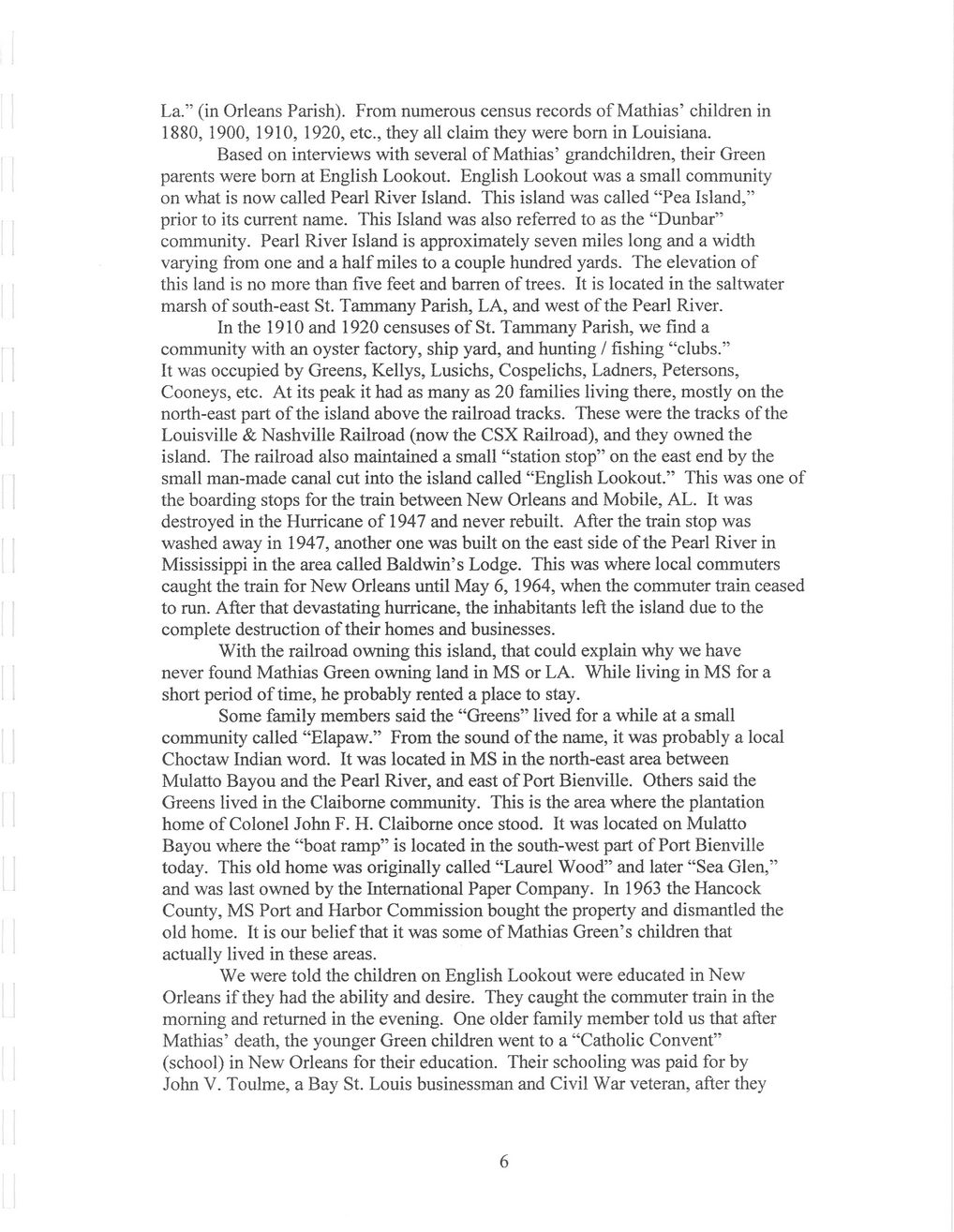This text was obtained via automated optical character recognition.
It has not been edited and may therefore contain several errors.
La.” (in Orleans Parish). From numerous census records of Mathias’ children in 1880, 1900, 1910, 1920, etc., they all claim they were bom in Louisiana. Based on interviews with several of Mathias’ grandchildren, their Green parents were bom at English Lookout. English Lookout was a small community on what is now called Pearl River Island. This island was called “Pea Island,” prior to its current name. This Island was also referred to as the “Dunbar” community. Pearl River Island is approximately seven miles long and a width varying from one and a half miles to a couple hundred yards. The elevation of this land is no more than five feet and barren of trees. It is located in the saltwater marsh of south-east St. Tammany Parish, LA, and west of the Pearl River. In the 1910 and 1920 censuses of St. Tammany Parish, we find a community with an oyster factory, ship yard, and hunting / fishing “clubs.” It was occupied by Greens, Kellys, Lusichs, Cospelichs, Ladners, Petersons, Cooneys, etc. At its peak it had as many as 20 families living there, mostly on the north-east part of the island above the railroad tracks. These were the tracks of the Louisville & Nashville Railroad (now the CSX Railroad), and they owned the island. The railroad also maintained a small “station stop” on the east end by the small man-made canal cut into the island called “English Lookout.” This was one of the boarding stops for the train between New Orleans and Mobile, AL. It was destroyed in the Hurricane of 1947 and never rebuilt. After the train stop was washed away in 1947, another one was built on the east side of the Pearl River in Mississippi in the area called Baldwin’s Lodge. This was where local commuters caught the train for New Orleans until May 6, 1964, when the commuter train ceased to run. After that devastating hurricane, the inhabitants left the island due to the complete destruction of their homes and businesses. With the railroad owning this island, that could explain why we have never found Mathias Green owning land in MS or LA. While living in MS for a short period of time, he probably rented a place to stay. Some family members said the “Greens” lived for a while at a small community called “Elapaw.” From the sound of the name, it was probably a local Choctaw Indian word. It was located in MS in the north-east area between Mulatto Bayou and the Pearl River, and east of Port Bienville. Others said the Greens lived in the Claiborne community. This is the area where the plantation home of Colonel John F. H. Claiborne once stood. It was located on Mulatto Bayou where the “boat ramp” is located in the south-west part of Port Bienville today. This old home was originally called “Laurel Wood” and later “Sea Glen,” and was last owned by the International Paper Company. In 1963 the Hancock County, MS Port and Harbor Commission bought the property and dismantled the old home. It is our belief that it was some of Mathias Green’s children that actually lived in these areas. We were told the children on English Lookout were educated in New Orleans if they had the ability and desire. They caught the commuter train in the morning and returned in the evening. One older family member told us that after Mathias’ death, the younger Green children went to a “Catholic Convent” (school) in New Orleans for their education. Their schooling was paid for by John V. Toulme, a Bay St. Louis businessman and Civil War veteran, after they 6

Green, Mathias Lundgren Mathias-Lundgren-Green-Family-of-South-MS-and-LA---Ancestors-and-Descendants-07